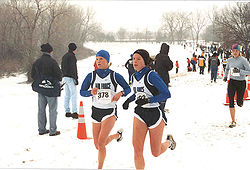Cross country running

Cross Country or trail running differs from traditional running in that instead of being run on a track or on the road, it occurs in natural areas such as on grass, dirt or mud, or even over water. It's also presents the added challenge of dealing with rough terrain like [[hills]. Because each course varies so widely in the amount and nature of the obstacles it delivers, it is difficult to compare times and achievement on different courses. In American high schools, races are typically 3 miles or 5 kilometers long. At the university level, they are 10 kilometers long. In professional running the courses vary in length up to 15k.
Notable cross country athletes include Kenenisa Bekele, an Ethiopian man who won the gold medal at the 2003 World Championships in Athletics in the 10k and the bronze medal in the 5k.
High School Cross Country
In American high schools, there are several different types of cross country events. Dual meets are faceoffs between two teams of 7 runners. Invitationals are larger events with dozens, possibly hundreds of teams entered. Invitationals usually occur in heats based on grade level. In both dual meets and invitationals, score is calculated by adding the number position of the top 5 runners on each team. Whichever team has the lowest score wins. In the event of a tie, whichever team had the lower-scoring 6th runner places higher.
